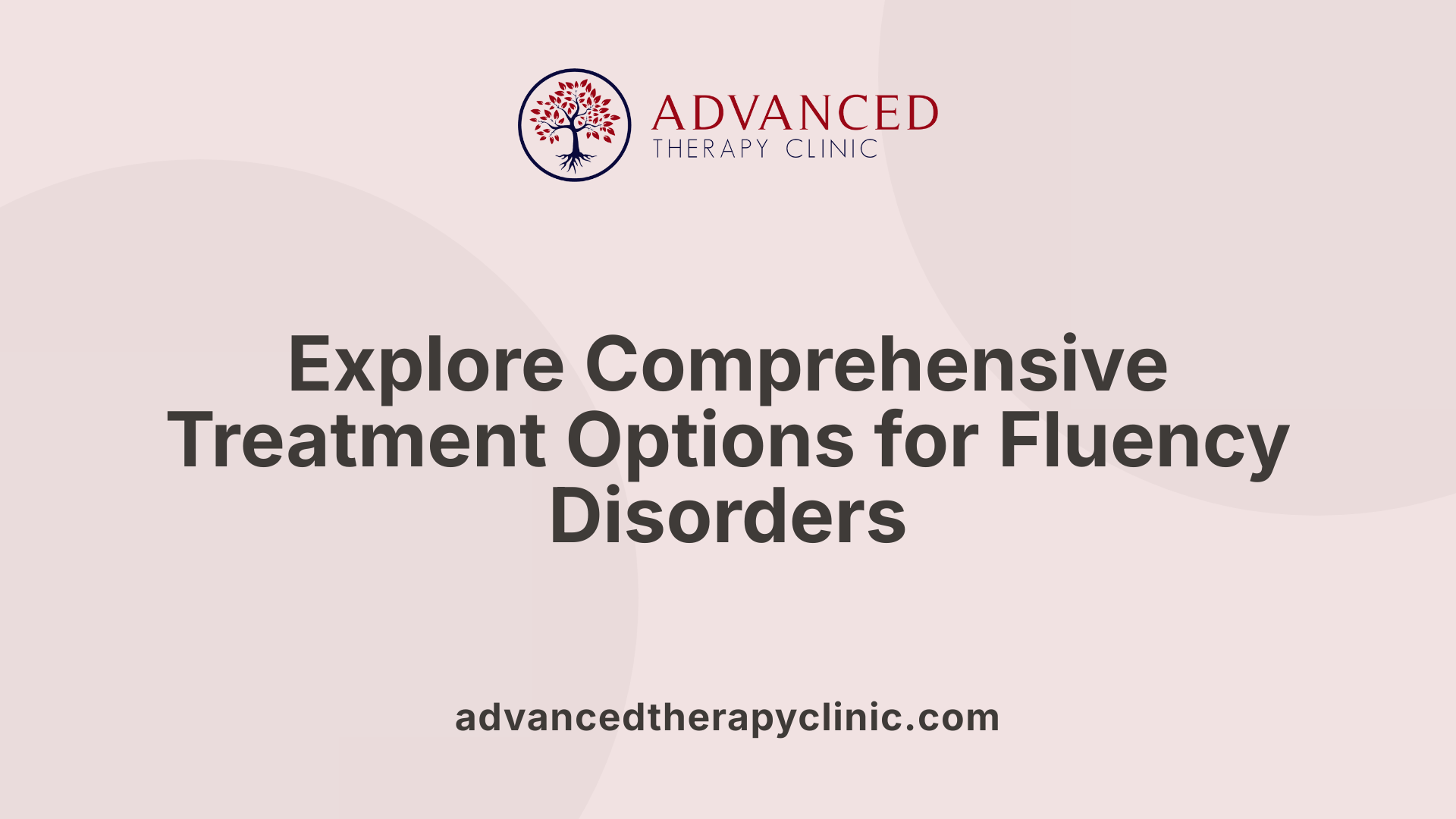How Speech Therapy Assists with Stuttering and Fluency Disorders


Understanding the Impact of Fluency Disorders and the Power of Speech Therapy
Fluency disorders, such as stuttering and cluttering, can significantly affect an individual's ability to communicate effectively and confidently. These challenges are often rooted in complex neurological, genetic, and developmental factors. Speech therapy emerges as a vital intervention, offering tailored strategies to improve speech flow, reduce disfluencies, and enhance overall wellbeing. This article explores how speech therapy supports individuals with fluency disorders, detailing assessment, treatment approaches, techniques, and the importance of early intervention.
Understanding Fluency Disorders: Causes, Signs, and Symptoms

What are the causes, signs, and symptoms of fluency disorders?
Fluency disorders, such as stuttering and cluttering, involve disruptions in the natural flow of speech. They are believed to result from a mix of genetic, neurophysiological, and environmental factors. Although the precise causes are not entirely clear, research indicates that genetics play a significant role, with stuttering often running in families. Neurophysiological differences, such as irregularities in neural pathways responsible for speech and language, particularly during early childhood development, can also contribute.
Stuttering is characterized by specific speech behaviors including repetitions of sounds or words, prolongations of speech sounds, and blocks—pauses where speech is momentarily halted. These disfluencies are often accompanied by physical tension or struggle, especially when a person is anxious or stressed. For example, a person might repeatedly say a syllable or hold the breath momentarily.
Cluttering, another fluency disorder, presents differently. It involves rapid, irregular speech that can be difficult to understand. People who clutter may speak too quickly, omit syllables or words, and may produce speech that is slurred or less logical in flow. This reduced clarity can hinder effective communication.
Risk factors that increase the likelihood of developing fluency issues include a family history of stuttering, developmental delays, or neurological conditions such as brain injury. Males are more frequently affected than females, indicating possible hormonal or developmental influences. Some cases of fluency disorder are neurogenic, linked to neurological damage or differences, while others might be psychogenic, stemming from emotional or psychological stress.
In addition to speech disruptions, individuals often experience emotional reactions like frustration, embarrassment, or shame. These feelings can lead to avoidance behaviors, further impacting social and educational participation.
Overall, fluency disorders influence how smoothly a person can communicate, affecting social interactions and personal confidence. Recognizing these signs early and understanding their causes can help guide appropriate assessment and intervention strategies.
The Central Role of Speech-Language Pathologists in Diagnosis and Treatment

How are fluency disorders diagnosed and assessed?
Fluency disorders, such as stuttering and cluttering, are primarily diagnosed and evaluated by trained speech-language pathologists (SLPs). Their comprehensive assessment process begins with collecting detailed case histories, including developmental background, family history, and any relevant medical or psychological factors.
Listen carefully to speech samples to identify disfluencies like repetitions (e.g., "I I I want"), prolongations (e.g., "ssssssee"), and speech blocks, which are pauses or stalls in speech. SLPs also observe secondary behaviors—actions such as eye blinking, facial tension, or hand movements—that may accompany disfluencies.
To gain a multidimensional understanding, many clinicians use standardized tools such as the Stuttering Severity Instrument (SSI-4) and questionnaires like the Overall Assessments of the Speaker's Experience of Stuttering (OASES). These instruments help quantify fluency severity, emotional reactions, and social impact.
Assessment extends beyond speech behaviors. It involves evaluating the emotional responses to disfluency, such as anxiety or frustration, which can influence treatment goals. In multilingual or culturally diverse clients, SLPs consider linguistic background and cultural factors to ensure culturally sensitive evaluation.
The ultimate aim of these assessments is to establish whether a fluency disorder exists, its severity, and specific speech patterns. This information guides the development of tailored, effective intervention plans tailored to each individual's needs.
What is the importance of individualized and culturally appropriate therapy strategies?
After assessment, SLPs craft personalized intervention strategies that respect each client's unique linguistic, cultural, and personal context. These strategies may include speech modification techniques like slow speech, controlled breathing, and gentle voice for reducing disfluencies.
Therapists also incorporate counseling and educational approaches to help clients understand their fluency patterns and develop coping mechanisms. For children, especially preschoolers, interventions like the Lidcombe Program focus on positive reinforcement of fluent speech, involving parents actively in therapy.
In school-age children and adults, therapy often includes practicing real-life speaking situations to promote generalization. Culturally appropriate materials and language considerations ensure that therapy respects the client's background, making it more effective.
SLPs use a combination of direct speech therapy exercises, behavioral techniques, and environmental modifications, aiming to enhance communication confidence and reduce emotional barriers to speaking.
How does assessment influence treatment planning?
Assessment findings directly inform individualized treatment plans. For example, a client with mild disfluencies focused on anxiety might benefit from cognitive-behavioral techniques integrated with speech modification. In contrast, a child with more severe stuttering may need intensive behavioral therapy coupled with family involvement.
Regular re-assessment tracks progress, adjusts goals, and modifies strategies as needed. By understanding the unique combination of speech patterns, emotional reactions, and environmental factors, SLPs ensure that therapy is targeted, effective, and supportive of long-term communication success.
| Aspect of Assessment | Description | Purpose |
|---|---|---|
| Speech Sample Analysis | Collection of speech during various activities | Identify disfluency types, frequency, and secondary behaviors |
| Observation of Reactions | Noting emotional and physical responses | Understand the emotional impact and coping mechanisms |
| Standardized Tests | Use of tools like SSI-4 and OASES | Quantify severity and impact on quality of life |
| Cultural and Linguistic Considerations | Assessment adaptations for languages and cultures | Ensure accurate diagnosis and appropriate intervention |
By thoroughly assessing speech disfluencies and their effects in context, SLPs can develop comprehensive, culturally sensitive, and personalized treatment plans, helping individuals improve their fluency and overall quality of life.
Treatment Modalities: From Speech Exercises to Psychological Support

What are the treatment options and approaches for fluency disorders?
Treatment for fluency disorders, including stuttering and cluttering, encompasses a variety of methods tailored to meet individual needs. Speech therapy serves as the primary approach, utilizing techniques such as speech modification, fluency shaping, and stuttering modification.
Speech modification techniques focus on developing a smoother speech pattern by controlling rate, using gentle onsets, and maintaining relaxed speech. Fluency shaping helps individuals produce continuous, fluent speech through prolonged sounds and smooth transitions. Stuttering modification, on the other hand, encourages speaking with less struggle by teaching easy onset of speech, gentle prolongations, and controlled breathing methods.
Beyond direct speech exercises, other components play vital roles. These include education and counseling to improve understanding and self-acceptance, which are crucial for boosting confidence. Family involvement, especially for young children, is emphasized to support practice and reinforce strategies in daily life.
Technological tools, such as electronic devices, can further enhance therapy. For example, delayed auditory feedback devices help individuals slow down their speech, making fluency more achievable during everyday conversation. These devices provide real-time feedback, fostering more natural speech patterns.
Psychological therapies like cognitive-behavioral therapy (CBT) are also integral to treatment. CBT addresses emotional and cognitive aspects by helping individuals manage anxiety, reduce negative thoughts, and develop positive coping strategies. This holistic approach aims not only to reduce disfluencies but also to improve emotional well-being and social participation.
Overall, effective management of fluency disorders requires early, personalized, and comprehensive treatment plans. These plans integrate speech therapy techniques, technological aids, psychological support, and active involvement of family and peers to promote sustainable communication improvements and enhance quality of life.
| Treatment Component | Specific Techniques | Goals |
|---|---|---|
| Speech Therapy | Fluency shaping, stuttering modification, controlled breathing | Improve speech fluency and rate |
| Technological Aids | Electronic devices like delayed auditory feedback | Enhance fluency through real-time feedback |
| Psychological Interventions | Cognitive-behavioral therapy, counseling | Manage emotional reactions, reduce anxiety |
| Family and Social Support | Modeling relaxed speech, acceptance strategies | Create supportive environment, boost confidence |
| Education and Self-advocacy | Teaching awareness, normalization, disclosure | Reduce stigma, promote social participation |
The variety of available approaches highlights the importance of a tailored, multidimensional treatment plan aimed at improving communication effectiveness, emotional resilience, and social integration for individuals with fluency disorders.
Therapeutic Techniques and Frameworks for Effective Speech Improvement

What are common speech therapy techniques and frameworks used for treating stuttering?
Stuttering therapy incorporates a variety of methods aimed at improving speech fluency and reducing the impact of disfluencies on individuals' lives. Among these, fluency shaping techniques are widely used. These include slowing down speech, employing diaphragmatic breathing, and maintaining continuous phonation. The goal is to produce speech that sounds natural and fluent by controlling speech rate and minimizing interruption patterns.
Stuttering modification strategies form another core component. These techniques focus on managing disfluencies directly through methods such as cancellations, pull-outs, and preparatory sets. Cancellations involve pausing after a stutter and then saying the word again more smoothly. Pull-outs help individuals smoothly ease out of a disfluency during speech. Preparatory sets involve planning to speak more fluently before initiating speech to lessen the chances of a stutter.
In addition to these, approaches like syllable-timed speech and gentle onsets help in maintaining a relaxed speech rhythm, especially effective with children. These methods emphasize gentle starts to speech sounds, reducing tension and physical struggle.
Cognitive-behavioral therapy (CBT) frameworks are also frequently integrated into treatment plans. They target emotional aspects such as anxiety and negative self-perceptions that often accompany stuttering. Techniques like cognitive restructuring challenge unhelpful thoughts, while acceptance and commitment therapy (ACT) promote psychological flexibility and self-acceptance.
Electronic devices have also become valuable adjuncts in therapy. For example, delayed auditory feedback devices modify how a person hears their speech, helping to slow down speech and improve fluency.
Beyond clinical methods, real-world practice plays a crucial role. Support groups provide social support and opportunities for practice in safe environments. Voluntary stuttering techniques where individuals intentionally produce disfluencies can also help desensitize fear and reduce avoidance behaviors.
The combination of these approaches—tailored to individual needs—creates a comprehensive framework that addresses not only speech mechanics but also emotional, cognitive, and social factors. This multi-modal approach ensures that therapy promotes overall communication confidence and participation, ultimately improving quality of life.
| Technique/Framework | Purpose | Additional Details |
|---|---|---|
| Fluency shaping | Producing fluent speech | Slowing speech, diaphragmatic breathing, continuous phonation |
| Stuttering modification | Managing moments of disfluency | Cancellations, pull-outs, preparatory sets |
| Gentle onsets & syllable timing | Smoother speech rhythm | Reduce tension, physical struggle |
| Cognitive-behavioral therapy | Address emotional reactions | Anxiety, negative thoughts, self-esteem issues |
| Electronic feedback devices | Assist in slowing speech | Delayed auditory feedback, lessens speech rate |
| Real-world practice | Maintain and generalize gains | Support groups, voluntary stuttering, real-life exercises |
By integrating these methods, speech-language pathologists craft personalized treatment plans that help individuals achieve more natural and confident speech, reducing the impact of stuttering on their daily lives.
The Broader Impact of Speech Therapy on Well-being and Social Participation

How does speech therapy help with stuttering and fluency disorders?
Speech therapy plays a vital role in helping individuals manage speech fluency issues like stuttering and cluttering. It focuses on teaching specific techniques that improve speech flow and reduce disfluencies. For example, fluency shaping methods encourage slower speech, controlled breathing, and gentle speech contacts, enabling more natural and less effortful speech patterns.
In addition to these physical speech strategies, therapists often incorporate fluency modification approaches, such as cancellations, pull-outs, and preparatory sets, which help the person manage moments of disfluency more effectively. These techniques help reduce struggle and tension during speech, making communication smoother.
Cognitive behavioral therapy (CBT) is also integrated into many treatment plans. CBT helps address negative thoughts, anxiety, and self-esteem issues related to stuttering. By targeting emotional and cognitive factors, therapy motivates individuals to participate more confidently in social settings.
Family involvement is especially important when working with children. It creates a supportive environment that reinforces positive speaking behaviors and reduces pressure or frustration.
Overall, speech therapy aims not only to minimize speech disruptions but also to build self-awareness, emotional resilience, and social confidence. This comprehensive approach helps individuals participate more fully in social, academic, and work-related activities, improving their overall quality of life.
Cultural, Developmental, and Technological Considerations in Therapy
Why is early intervention and family involvement critical in therapy?
Early treatment of stuttering can significantly improve the prognosis for children who experience speech disfluencies. When parents and caregivers actively participate in therapy, they help create a supportive environment that reinforces positive speaking habits. This involvement is especially vital during preschool years when speech and language skills are rapidly developing.
For young children, therapy typically involves either indirect or direct methods. Indirect approaches focus on modifying the child's speaking environment, such as reducing speaking pressures and creating a calm atmosphere. Direct techniques, on the other hand, employ behavioral strategies, including specific speech modifications, to help children speak more fluently.
Caregivers play a crucial role in supporting therapy by modeling relaxed, unhurried speech, accepting disfluencies without negative reactions, and emphasizing the importance of content over fluency. This approach not only reduces anxiety associated with speaking but also enhances a child's confidence and willingness to communicate.
Involving families in therapy ensures consistency and reinforces learned skills outside the clinical setting. It helps in addressing any emotional or social challenges linked to stuttering and minimizes negative peer reactions that could lead to avoidance behaviors.
How do cultural and linguistic factors influence assessment and treatment?
Assessment and intervention must be culturally and linguistically appropriate to ensure effectiveness. For multilingual children or those from diverse cultural backgrounds, it is essential to involve interpreters or bilingual clinicians when necessary.
Tailoring therapy to reflect the child's language skills, cultural practices, and family values can improve engagement and outcomes. Speech-language pathologists should be sensitive to cultural differences, including communication norms and attitudes toward stuttering.
What is the role of electronic devices in enhancing fluency?
Technological tools such as delayed auditory feedback devices and real-time speech modification feedback systems are increasingly used in therapy. These electronic devices help individuals slow down their speech, providing real-time feedback that promotes more natural speech patterns.
In daily use, these tools support ongoing practice outside the clinical environment, making speech therapy more practical and accessible. They can boost confidence and facilitate gradual fluency improvements by reducing perceptual and production difficulties.
The importance of age-appropriate approaches
Early intervention strategies are designed to suit the child's developmental stage. For preschoolers, techniques like the Lidcombe Program promote positive reinforcement of fluent speech and involve parents directly.
In school-age children, adolescents, and adults, therapy is tailored to their individual social and professional needs. For instance, older clients might focus on strategies to manage anxiety, improve confidence, and develop effective communication skills.
Using age-appropriate and culturally sensitive approaches helps individuals of all ages achieve better participation in social, educational, and occupational activities.
| Aspect | Application | Notes |
|---|---|---|
| Early Intervention | Timely therapy for children | Increases successful outcomes, prevents negative social reactions |
| Family Involvement | Modeling relaxed speech, providing support | Critical for creating a positive environment, reinforcing skills |
| Cultural and Linguistic Appropriateness | Using interpreters, culturally aware practices | Ensures engagement and effectiveness across diverse populations |
| Technology Use | Feedback devices like delayed auditory feedback | Supports independence and speech practice outside therapy |
| Age-Appropriate Techniques | Lidcombe Program for preschoolers, fluency strategies for older clients | Aligns methods with developmental needs |
Combining these factors provides a comprehensive approach to managing fluency disorders. It emphasizes the importance of considering each individual’s cultural background, age, and access to technology to optimize therapy success.
Empowering Effective Communication Through Speech Therapy
Speech therapy offers a comprehensive, personalized approach to managing fluency disorders, significantly improving individuals’ ability to communicate confidently and effectively. Through detailed assessment, targeted techniques, psychological support, and family involvement, speech-language pathologists help reduce disfluencies, foster self-acceptance, and promote social participation. Early intervention and culturally sensitive practices further enhance therapy outcomes. Although complete eradication of stuttering may not always be possible, the skills gained through speech therapy empower individuals to lead more connected, expressive, and fulfilling lives.
References
- Speech Therapy for Stuttering and Fluency Disorders
- What One Speech Therapist Wishes You Knew About ...
- Stuttering, Cluttering, and Fluency
- Stuttering - Diagnosis and treatment
- Understanding the Speaker's Experience of Stuttering Can ...
- Fluency Disorder: Symptoms, Causes & Treatment
- Fluency Disorders - UCF Communication Disorders Clinic
Recent articles

How Autism Affects Daily Life Adults
Understanding the Complexities of Autism in Adult Daily Life

What Is Speech Sound Disorder
Understanding Speech Sound Disorders: An In-Depth Exploration

Autism Stimming Behaviors
Understanding the Complex World of Autism Self-Regulation

The Benefits of Occupational Therapy for Enhancing Attention to Task
Enhancing Focus and Engagement in Children Through Occupational Therapy

What Is Virtual Autism
Unveiling the Symptoms, Causes, and Prevention of Virtual Autism

ICD-10 Code For Autism
Understanding the ICD-10 Classification for Autism Spectrum Disorder


